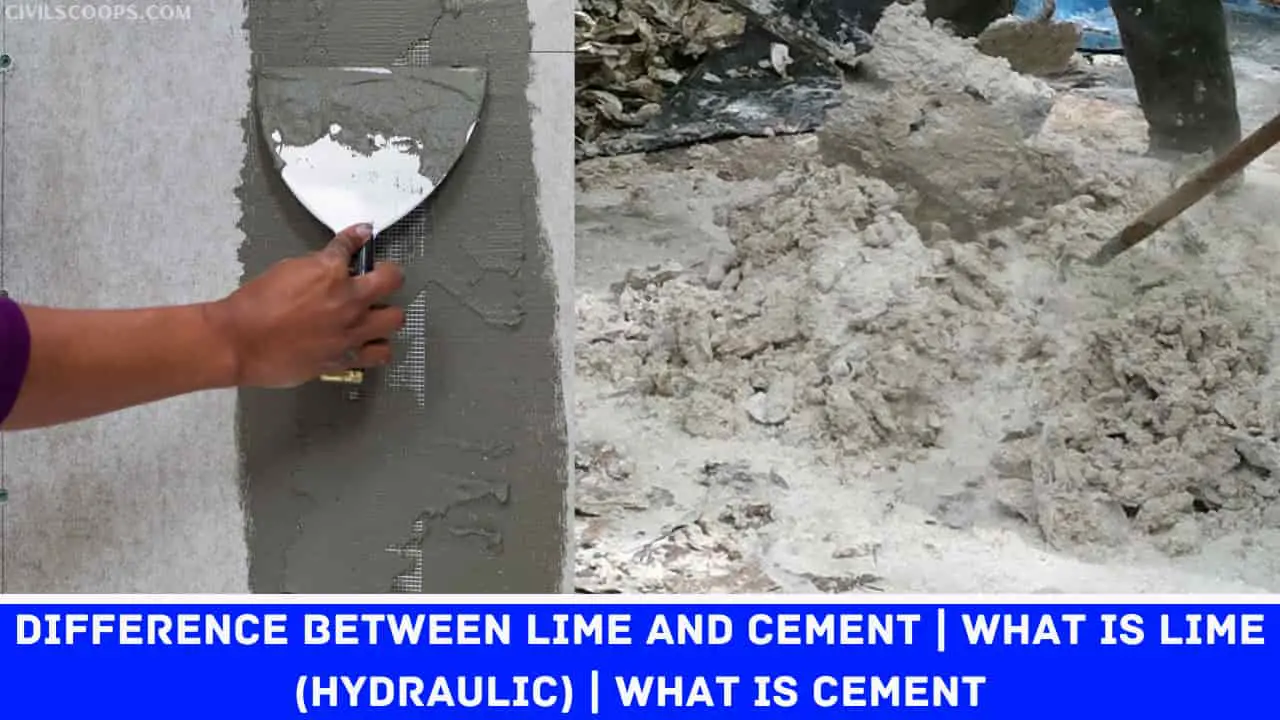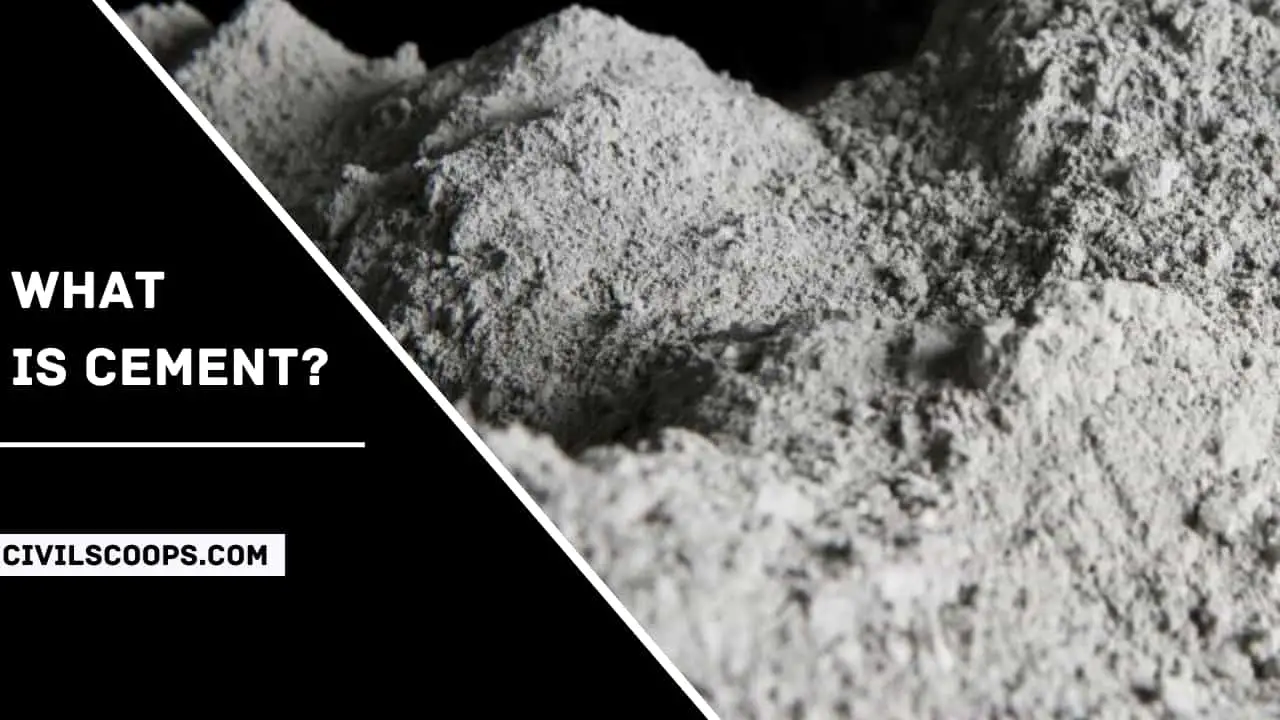Difference Between Lime and Cement | What Is Lime (Hydraulic) | What Is Cement

Table of Contents
What Is Lime (Hydraulic)?
It is an important binding material used in building construction. Lime has been used as the material of construction from ancient times.
When it is mixed with sand it provides lime mortar and when mixed with sand and coarse aggregate, it forms lime concrete. Lime is a good building material for construction its use in the construction of foundations, walls, plastering, white washing is known to you.
Structures like forts monuments, please, bridges constructed years back stands today in good condition of time. The use of lime has been reduced with the introduction of cement. This is because of cement.
- Takes less timer fro setting
- Has More Strength
- Having desired Properties
- Stored for longer periods etc.
Types of Limes
- Fat lime:
- Hydraulic lime:
- Poor lime:
What Is Cement?

Cement is a commonly used binding material in the construction. The cement is obtained by burning a mixture of calcarious (calcium) and argillaceous (clay) material at a very high temperature and then grinding the clinker so produced to a fine powder.
It was first produced by a mason Joseph Aspdin in England in 1924. He patented it as portland cement.
Different Types of Cement
[su_table responsive=”yes” alternate=”no”]
| Sr.No. | Type of Cement |
| 1 | Ordinary Portland Cement (OPC) |
| 2 | Portland Slag Cement |
| 3 | Portland Pozzolana Cement (PPC) |
| 4 | Coloured Cement/White Cement |
| 5 | Sulphate Resisting Cement |
| 6 | Low Heat Portland Cement |
| 7 | Rapid Hardening Cement |
| 8 | Hydrophobic Portland Cement |
| 9 | Extra Rapid Hardening Cement |
| 10 | Quick Setting Cement |
| 11 | Super Sulphated Cement |
| 12 | Portland Pozzolana Cement (Fly ash based) |
| 13 | Portland Pozzolana Cement (Calcined based) |
| 14 | Air Entraining Cement |
| 15 | Masonry Cement |
| 16 | Expansive Cement |
| 17 | Oil Well Cement |
| 18 | Rediset Cement |
| 19 | Concrete Sleeper Grade Cement |
| 20 | High Alumina Cement |
| 21 | Very High Strength Cement |
[/su_table]
Difference Between Lime and Cement
[su_table responsive=”yes”]
| Sr.No. | Detail | Lime (Hydraulic) | Cement |
| 1 | Slaking |
|
|
| 2 | Setting |
|
|
| 3 | Binding |
|
|
[/su_table]
[su_box title=”FAQ” style=”default” box_color=”#333333″ title_color=”#FFFFFF” radius=”3″ class=”” id=””]
Lime vs Cement
Lime hardens much more slowly than cement-containing mortars, making it much more workable. Lime is also less brittle and less prone to cracking, and any cracked areas can absorb carbon dioxide and mend over time. The cement hardens very quickly, but may be too strong for some applications, e.g., working with old bricks.
Lime Concrete in Foundation
Lime concrete is very widely used for foundation bases of load bearing walls, columns, and under layers of floors. Due to its flexibility it adjusts very well with the underneath base ground and upper construction of cement base. For better quality of lime concrete it is important to compact & cure concrete properly.
Hydrated Lime Mortar
Hydrated lime is the type of lime most widely used as a component in mortars and renders. Hydrated lime, and quicklime (see below) are commonly referred to as ‘air lime’ products. This is because they do not react with the water in the mix to form a ‘set’.
Difference Between Lime and Cement
Lime hardens much more slowly than cement-containing mortars, making it much more workable. Lime is also less brittle and less prone to cracking, and any cracked areas can absorb carbon dioxide and mend over time. Cement hardens very quickly, but may be too strong for some applications, e.g.
Why Add Lime to Cement?
Incorporating an appropriate proportion of hydrated lime into a cement-based mixture improves plasticity and workability, making the product easier to handle on the trowel. Hydrated lime also increases water retention which helps to improve the contact and bond with the substrate.
Percentage of Lime in Cement
The cement contains 35 to 40 percent lime, 40 to 50 percent alumina, up to 15 percent iron oxides, and preferably not more than about 6 percent silica. The principal cementing compound is calcium aluminate (CaO · Al2O3).
Portland Cement Sand and Lime Mix Ratio
This Portland Cement-Lime Mix, when mixed with 1:2¼ to 1:3½ cubic feet of sand meeting ASTM C144 Specifications, will produce a mortar that meets the property specification requirements of ASTM C270 for Type N, Type S, or Type M portland cement-lime mortar (Table 1). Machine mixing should be used whenever possible.
How Much Lime to Add to Mortar Mix?
Mix in 1 part lime. Followed by 1.5 parts sand. Mix dry for at least 5 minutes. After 5 minutes slowly add water until the desired consistency is reached, it is very important not to drown the mix by adding too much water.
[/su_box]
[su_note note_color=”#F2F2F2 ” text_color=”#333333″ radius=”3″ class=”” id=””]
Like this post? Share it with your friends!
Suggested Read –
- What Is Sheepsfoot Roller? | Characteristics of Sheepsfoot Rollers | Difference Between Padfoot and Sheepsfoot Rollers
- Monolithic Slab I Monolithic Definition I Monolithicfooting I Monolithic Slab Foundationl Monolithic Slab Foundation Design L What Is a Monolithic Slab L How to Form a Monolithic Slab
- What Is a Spillway | Types of Spillway | Definition Spillway | Spillway Design
- What Is Workability | What Is Workability of Concrete | Types of Workability of Concrete | Factors Affecting Workability of Concrete
- Types of Curing | Concrete Curing Time | How to Cure a New Concrete Slab | What Is Curing of Concrete | How Long Does Concrete Take to Dry | How Long Does It Take for Cement to Dry
[/su_note]
Originally posted 2022-07-13 19:47:02.
